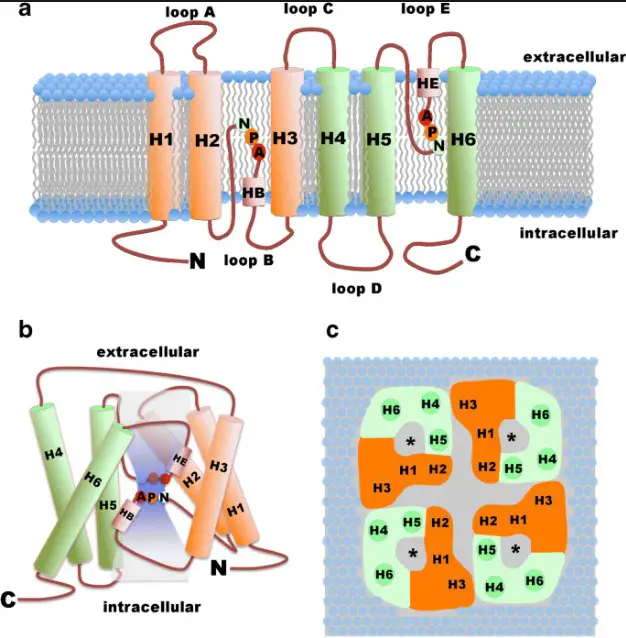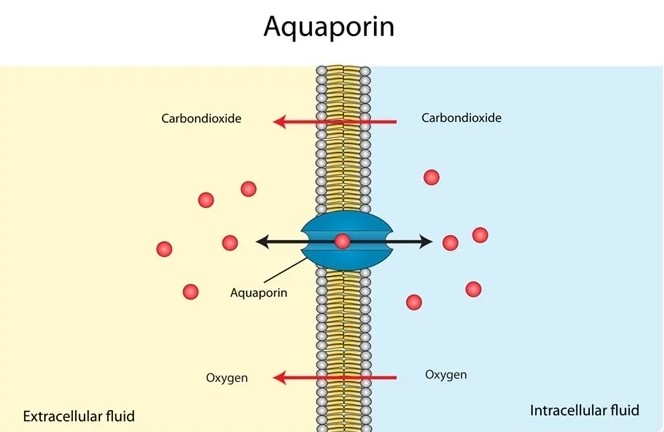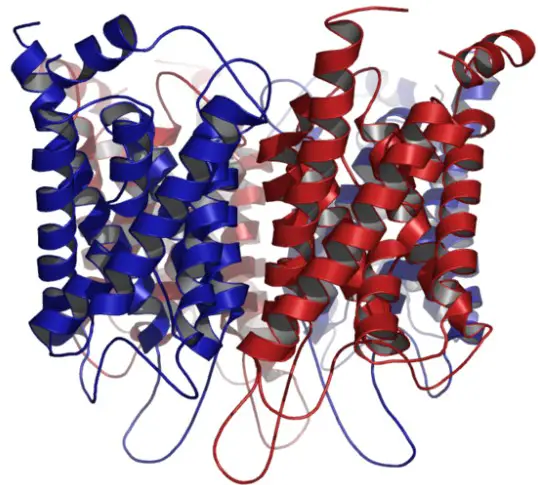Cellular functions are deeply influenced by the complex orchestra of proteins embedded in the biological membranes of cells. Among these, porins and aquaporins play crucial roles in regulating the flow of substances across these membranes. Their distinct functionalities and structures are fundamental to understanding how cells maintain homeostasis, respond to environmental changes, and facilitate various life-sustaining processes.
Porins and aquaporins are membrane proteins, but they differ significantly in function and structure. Porins generally form channels that allow the passive diffusion of ions and small molecules across cell membranes, mainly in bacteria. Aquaporins, on the other hand, are specialized for the rapid transport of water molecules in and out of cells, playing a key role in regulating cellular water content across a wide range of life forms, from bacteria to humans.
The study of these proteins provides insights into cellular physiology, offering clues to how organisms adapt to their environments and manage nutrient and water uptake. Beyond their biological significance, understanding porins and aquaporins has practical implications in medicine, biotechnology, and environmental science, influencing the development of antibiotics, water purification systems, and treatments for various diseases.

Porins Overview
Structure
General Characteristics
Porins are a class of proteins that form channels through the outer membranes of cells, particularly in bacteria, mitochondria, and chloroplasts. These proteins are crucial for the transport of molecules between the cell and its environment. Porins are typically beta-barrel proteins, characterized by their barrel-shaped structure made from beta strands. This structure allows for a pore in the center through which molecules can pass. The size and charge of the pore determine the specificity of the transport.
Types and Distribution
Porins vary widely in types, reflecting their diverse roles in different organisms. They can be broadly categorized into general porins, which allow the passive diffusion of small molecules, and specific porins, which are selective for particular substrates. General porins are found across various bacteria, providing a basic means of nutrient intake and waste removal. Specific porins, on the other hand, are tailored for the transport of specific molecules like sugars, amino acids, and ions, reflecting a more regulated cellular entry and exit pathway. The distribution of porins is not limited to prokaryotes; eukaryotic organelles like mitochondria and chloroplasts also contain porins, playing essential roles in their functions.
Function
Role in Molecule Transport
Porins facilitate the movement of molecules across the cell membrane, acting as a gateway for nutrients, ions, and other essential substances. They operate through a passive transport mechanism, allowing substances to move along their concentration gradient without the need for cellular energy (ATP).
Specificity and Regulation
The specificity of porins is determined by the size and charge of their pores, allowing only molecules of certain sizes or charges to pass through. This selectivity is crucial for the cell’s ability to regulate its internal environment. Furthermore, the expression of porins can be regulated by the cell in response to environmental changes, such as variations in nutrient availability or osmotic pressure, ensuring the cell can adapt to different conditions.
Aquaporins Overview
Structure
Unique Features
Aquaporins stand out for their highly selective water channel activity. Unlike porins, aquaporins are integral membrane proteins with a distinctive hourglass structure formed by alpha helices. This structure includes a narrow pore, perfectly sized to transport water molecules while excluding ions and other solutes. This specificity is attributed to the unique amino acid composition at the pore’s narrowest region, ensuring that only water molecules can pass through.
Types and Distribution
There are several types of aquaporins, each with specific tissue and cell type distributions. These include water-only channels (classical aquaporins) and aquaglyceroporins, which can transport glycerol in addition to water. Humans and other organisms express different aquaporins in various tissues, reflecting the diverse physiological needs for water transport, such as in the kidneys, brain, and plant roots.
Function
Water Transport Mechanism
Aquaporins facilitate rapid water transport across cell membranes, responding to osmotic gradients. This process is vital for maintaining cellular water balance, crucial for cell volume regulation, and contributes to the transport of fluids in tissues.
Role in Cellular Water Balance
In tissues like the kidney, aquaporins play a critical role in concentrating urine and conserving water in the body. They are also integral in plant roots for absorbing water from the soil and in salivary glands for saliva production. The regulation of aquaporin activity is essential for the body’s water homeostasis, influencing hydration levels, tissue swelling, and fluid secretion.
Key Differences
Molecular Transport
Porins and aquaporins differ primarily in the substances they transport. Porins allow a broad range of molecules including ions, sugars, and amino acids to pass through, based on size and charge. Aquaporins, however, are highly specialized for water transport, with some variants also transporting small molecules like glycerol.
Structural Distinctions
The structural differences between porins and aquaporins are significant, with porins forming beta-barrel structures and aquaporins forming alpha-helix channels. These structural variations are closely related to their functions, with the specific shapes and compositions of these proteins allowing for their unique transport capabilities.
Regulatory Mechanisms
Regulation is another area where porins and aquaporins differ. While both can be regulated in response to environmental changes, the mechanisms of regulation vary. Aquaporins can be regulated by phosphorylation, affecting their water transport activity, whereas porins can be regulated by changes in gene expression, altering their presence in the cell membrane.

Health Implications
Porins
Impact on Bacterial Resistance
Porins play a critical role in bacterial resistance to antibiotics. Some bacteria can alter the structure of their porins or regulate their expression to reduce permeability to antibiotics, effectively making themselves more resistant. This mechanism of resistance is particularly seen with beta-lactam antibiotics, where changes in porin channels can prevent the antibiotics from reaching their target sites within the bacteria. Understanding these changes is crucial for developing new antibiotics that can overcome this resistance mechanism.
Role in Vaccine Development
Porins are also promising targets in vaccine development. Due to their surface location and role in disease processes, porins can evoke an immune response. Vaccines that utilize porin proteins can stimulate immunity against pathogens by presenting these proteins to the immune system, prompting it to recognize and combat the pathogen more effectively in future encounters. This approach has been explored in vaccines against meningitis and other bacterial infections, where porins’ unique properties make them suitable candidates for subunit vaccines.
Aquaporins
Involvement in Human Diseases
Aquaporins are implicated in a variety of human diseases due to their role in water balance. Their dysfunction or misregulation can lead to conditions such as brain edema, where excessive water accumulation causes swelling, and nephrogenic diabetes insipidus, a kidney-related condition where the body cannot concentrate urine, leading to excessive water loss. Understanding aquaporins’ involvement in these diseases is key to identifying potential diagnostic markers and treatment targets.
Potential Therapeutic Targets
Given their critical role in water transport and homeostasis, aquaporins present as potential therapeutic targets. Modulating aquaporin activity could help treat conditions related to water imbalance. For instance, inhibiting certain aquaporins in the brain could reduce edema, while activating them in the kidneys could help in conditions like congestive heart failure, where fluid retention is a problem. Research into aquaporin inhibitors and activators is ongoing, with the aim of developing targeted therapies for these conditions.
Environmental and Biotechnological Applications
Water Purification
Aquaporins in Biomimetic Membranes
Aquaporins are revolutionizing water purification technology through their integration into biomimetic membranes. These membranes mimic the selective water transport of aquaporins, allowing for highly efficient and selective water filtration. This technology holds promise for producing clean drinking water, treating wastewater, and desalinating seawater with higher efficiency and lower energy consumption than traditional methods.
Bioremediation
Use of Porins in Environmental Cleanup
Porins are being explored for their potential in bioremediation, the process of using organisms to clean up pollutants. Genetically engineered bacteria with modified porins can be designed to have an enhanced uptake of specific contaminants, such as heavy metals or organic pollutants. These bacteria can then break down or sequester pollutants from contaminated sites, offering a promising tool for environmental cleanup efforts.
Recent Advances
Research Developments
Cutting-Edge Discoveries in Structure and Function
Recent research into porins and aquaporins has led to groundbreaking discoveries regarding their structure and function. Advanced imaging techniques, such as cryo-electron microscopy, have provided detailed views of these proteins at the atomic level, revealing how they manage to be both highly selective and efficient. These insights are crucial for understanding how these proteins function under physiological conditions and how they can be manipulated for therapeutic or technological applications.
Technological Innovations
Applications in Medicine and Biotechnology
The detailed understanding of porins and aquaporins has paved the way for innovative applications in medicine and biotechnology. For instance, aquaporins are being used to develop next-generation contact lenses that offer superior comfort by maintaining hydration. In medicine, porin-based nanoparticles are explored for targeted drug delivery, allowing drugs to be more efficiently transported into cells. These and other technological innovations showcase the potential of these proteins to contribute to various fields, from healthcare to environmental science.
Frequently Asked Questions
What are Porins?
Porins are a type of protein that form channels across the outer membranes of bacteria, mitochondria, and chloroplasts. They facilitate the passive transport of small molecules like ions, sugars, and amino acids, helping to regulate the exchange of nutrients and waste between a cell and its environment. Their structure allows them to act as a selective barrier, ensuring only specific molecules can pass through.
How do Aquaporins Function?
Aquaporins are integral membrane proteins that specifically facilitate the transport of water molecules across cell membranes. They operate through a mechanism that allows rapid water flow while blocking ions and other solutes, thus playing a critical role in controlling water balance in cells. Their activity is essential for processes such as kidney filtration, plant water management, and cellular hydration in various organisms.
Why are Aquaporins Important in Medicine?
Aquaporins have been linked to several medical conditions, including kidney diseases, brain edema, and eye disorders. Their pivotal role in water transport makes them potential targets for therapeutic interventions. For example, modulating aquaporin function could lead to new treatments for conditions involving abnormal water retention or dehydration, offering novel approaches to managing these diseases.
Can Porins be Targeted by Antibiotics?
Porins can indeed be targeted by certain antibiotics, particularly in the treatment of bacterial infections. Since porins are involved in nutrient uptake in bacteria, blocking these channels can starve bacteria of essential nutrients, inhibiting their growth. This strategy is part of the ongoing research to overcome antibiotic resistance, making porins a focus in the development of new antibacterial therapies.
Conclusion
The intricate dance of porins and aquaporins across cell membranes illustrates the complexity of life at a microscopic level. These proteins not only underpin fundamental physiological processes but also offer gateways to understanding more about life itself. By exploring their structures and functions, scientists continue to uncover the vast interconnectivity of cellular mechanisms, shedding light on the potential for innovative treatments and technologies.
As we advance our understanding of porins and aquaporins, their significance extends beyond the confines of cell biology into practical applications in medicine, biotechnology, and environmental science. The study of these proteins is a vibrant field of research, promising new insights and tools for addressing some of the most pressing challenges in human health and sustainability.

